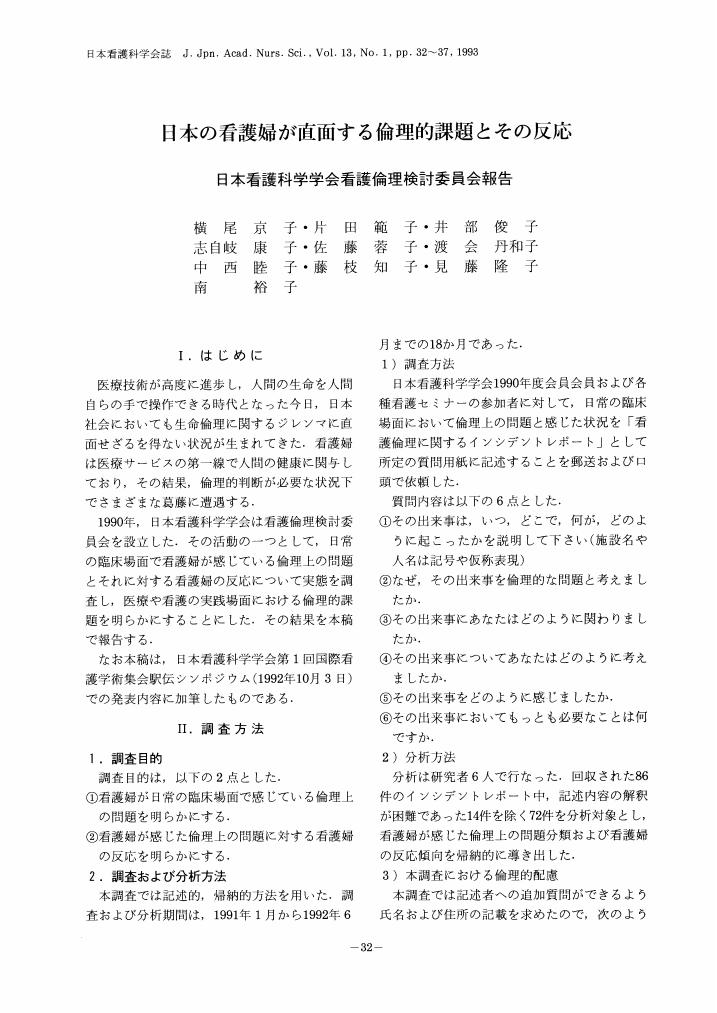2 0 0 0 OA 第17回日本助産学会学術集会集録 ワークショップ (その2)
1 0 0 0 OA 日本の看護婦が直面する倫理的課題とその反応 日本看護科学学会看護倫理検討委員会報告
1 0 0 0 IR 予防接種における年少幼児の行動の類型化--親、医療者との関わりの視点から
- 著者
- 茶圓 智子 横尾 京子 中込 さと子
- 出版者
- 広島大学保健学出版会
- 雑誌
- 広島大学保健学ジャーナル (ISSN:13477323)
- 巻号頁・発行日
- vol.6, no.2, pp.102-110, 2007-09
本研究は, 予防接種における2歳から3歳の年少幼児の行動を類型化し, 行動の持つ意味を親や医療者の関わりの視点から考察し, 予防接種への対処を助けるために必要とされる看護ケアについて検討することを目的とした. 対象は日本脳炎の予防接種を受けた健康な2歳から3歳の年少幼児とした. データ収集は平成14年7月26日から同年9月12日までの1.5か月に行い, M小児科医院外来で行った. データ収集方法は, ビデオカメラを用いて, 第1回および第2回の日本脳炎予防接種の来院時点から帰院までの幼児の一連の行動と親, 兄弟, 医療者の行動を含めて撮影・録画した. データ分析は, 画像は事例別に全行動を言語で記述し, 予防接種に対する反応に関連する行動を抽出し, 幼児の予防接種に対する反応の出現時期(嫌がる時期, 泣き始める時期, 痛いと言う時期, 泣き止んだ時期), および, 幼児と医療者・親・兄弟との関わりを抽出し, 予防接種を受ける対象の行動の類型化を行った.その結果, 予防接種における年少幼児の行動は, 嫌がり・泣き始め・泣き止みの時期, 痛いという表現, 第1回・第2回の行動の相違点から, 3つに類型化した. タイプⅠの行動は, 第1回・第2回とも注射針刺入までに嫌がり泣き始め, タイプⅡの行動は, 第1回・第2回とも注射終了後に痛いと言って泣き始め, タイプⅢは, 第2回においてのみ注射針刺入時に痛いと言い液注入時に泣き始めるという行動であった. 年少幼児でも, 他者と注射の方法や意義について理解できること, 嫌がり・泣きがあってもがんばろうとしていたこと, 痛みに耐えようとしても耐えられないと泣いてしまうこと, 注射を見ることで不安が増強すること, 反応の内容や強さは個人差があることが考えられた.年少幼児の予防接種におけるケアとしては, 1)がんばるという心構えを支えること, 2)痛み体験を受け止め, がんばったことをほめる, 3)痛みを緩和すること, 4)注射部位の固定・注射の準備の仕方, 5)個別なアセスメントを行うことが示唆された.The purpose of this research is to find patterns in the behavior of infants during immunization injections and to ascertain the care needed when dealing with infants at vaccination. The subjects were five infants (aged from 2 years 11 months to 3 years 8 months old) who received immunization injections for Japanese encephalitis. The data was collected using a video camera of a series of interactions between the subjects, parents, siblings, and the medical treatment staff from their arrival at the clinic to their departure. Semi-structured interviews with the parents were also used to obtain information about the background of the subjects.As a result of inductive and descriptive analysis, the behavior of infants during immunization injections could be classified into three types. Infants of type I showed their dislike of the injection and cried before the prick of the needle at both the first and second injections. Infants of type II complained that it was painful and began to cry after the injection was over at both the first and second injections. Infants of type III said that it was painful at the prick of the needle but cried only during the second injection.Infants could talk with others about the meaning and the method of the vaccination. They tried to bear with the discomfort even though they disliked it and wanted to cry.When they could not endure it, they cried with pain. Seeing the syringe increased their anxiety. There were also individual differences in the strength of their reaction.Based on the infants' backgrounds and their behavior according to type, points relating to the care of infants during vaccination were enumerated as follows: 1) Child's determination to do his/her best. 2) Understand the infant's experience of pain and praise his/her endurance. 3) Consider methods of easing the pain. 4) Devise a method choosing the injection spot and for preparing the materials of the injection. 5) Individual assessment and correspondence.
1 0 0 0 IR 早産児の体重測定法--「包み込み」によるストレス緩和の検討
- 著者
- 山田 ひとみ 坂本 裕子 米中 由美 内谷 文子 阿曽沼 洋子 中島 由美子 横尾 京子
- 出版者
- 日本新生児看護学会
- 雑誌
- 日本新生児看護学会誌 (ISSN:13439111)
- 巻号頁・発行日
- vol.9, no.1, pp.40-45, 2002-09
本研究は、体重測定時に「包み込み」を行うことにより、早産児のストレスを緩和できるか否かを明らかにすることを目的とした。当施設での裸のままで保育器外へ出す体重測定法(従来法)と、児をタオルで囲い頭部以外の身体を布で覆った状態で出すという体重測定法(包み込み法)を、早産児4事例において、各方法12場面(4名×3回)を交互に行った。体重測定前の児の状態を安静とし、体重測定中・体重測定後0~5分の5分間・体重測定後6~10分の5分間の各時期を、行動学的側面(ストレスサイン・state)から比較検討し、以下の結果を得た。ストレスサインにおいては、体重測定中では14項目中7項目で有意差が認められ、体重測定後0~5分の5分間・6~10分の5分間においても体重測定中よりは少数であるが、有意差が認められた。stateにおいては、包み込み法では体重測定中に全く上昇が見られないという結果が得られた。これらより、「包み込み」は体重測定中の早産児のストレスを緩和するのに有用であると示唆された。今後もあらゆるケアにおいて、児のストレスサインを適切に読み取り、対処法を探索していく必要がある。The purpose of the present research was to clarify whether or not the stress of preterm infants can be relieved by "wrapping up" during measurement of their body weight. The body weights of four preterm infants were measured using alternately our facility's traditional method, whereby babies are taken naked as they are from the incubator ("traditional method"). and a method whereby the infants were taken out clothed in a towel so that their bodies except for the head were covered in fabric ("wrap-up method"). Each infant's body weight was measured 3 times using the two methods, making a total of 12 cases. Before weight measurement the infants were put into a restful state; subsequently they were examined for behavioral aspects (stress signs and state) during (a) weight measurement. (b) the 5 minute period immediately after weight measurement (minutes 0 to 5). and (c) the subsequent 5 minute period (minutes 6 to 10). Below are the results of the comparison that was made of the behavioral aspects in each of these periods. A significant difference occurred in stress signs during weight measurement, with just 7 out of 14 signs being observed with the wrap-up method. During the 1st (minutes 0-5) and 2nd (minutes 6-10) 5 minute periods following weight measurement the number of stress signs observed was small compared to those occurring during weight measurement, but again there was a significant difference. As regards stress state, the result obtained was that no increase whatever was observed during weight measurement when the wrap-up method was used. These results indicate that the wrap-up method is useful for relieving stress in premature babies during body weight measurement. In the future it will be necessary to read accurately the stress signs in babies under all types of care and to explore methods to remedy such stress.

